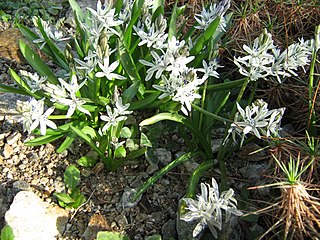
Scilloideae is a subfamily of bulbous plants within the family Asparagaceae. Scilloideae is sometimes treated as a separate family Hyacinthaceae, named after the genus Hyacinthus. Scilloideae or Hyacinthaceae include many familiar garden plants such as Hyacinthus (hyacinths), Hyacinthoides (bluebells), Muscari and Scilla and Puschkinia. Some are important as cut flowers.

Ornithogalum is a genus of perennial plants mostly native to southern Europe and southern Africa belonging to the family Asparagaceae. Some species are native to other areas such as the Caucasus. Growing from a bulb, species have linear basal leaves and a slender stalk, up to 30 cm tall, bearing clusters of typically white star-shaped flowers, often striped with green. The common name of the genus, star-of-Bethlehem, is based on its star-shaped flowers, after the Star of Bethlehem that appears in the biblical account of the birth of Jesus. The number of species has varied considerably, depending on authority, from 50 to 300.

Galtonia is a genus of plants in the family Asparagaceae, subfamily Scilloideae. Native to Southern Africa, the genus is named after Sir Francis Galton. According to some authorities it has been subsumed into Ornithogalum as a subgenus, while others prefer to keep it as a separate genus.

Massonia is a genus of bulbous perennial flowering plants in the family Asparagaceae, subfamily Scilloideae. It is native to southern Africa, and is found in localities such as Namaqualand with hot and dry summers, being dormant in summer and growing during winter. The genus Whiteheadia has been merged into Massonia. It is classed as a cryptophyte.

Strumaria is a genus of African plants in Amaryllis family, subfamily Amaryllidoideae. The genus is known in nature only from South Africa, Lesotho and Namibia. Almost all species flower in the autumn and are cultivated as ornamental bulbous plants.

Albuca is a genus of flowering plants in the family Asparagaceae, subfamily Scilloideae. The genus is distributed mainly in southern and eastern Africa, with some species occurring in northern Africa and the Arabian Peninsula. Plants of the genus are known commonly as slime lilies.

Scilla sardensis, the lesser glory-of-the-snow, is a bulbous perennial from west Turkey flowering in early spring. After flowering, it goes into dormancy until the next spring. It belongs to a group of Scilla species that were formerly put in a separate genus, Chionodoxa, and may now be treated as Scilla sect. Chionodoxa.

Drimia is a genus of African, south European and south Asian flowering plants. In the APG IV classification system, it is placed in the family Asparagaceae, subfamily Scilloideae. When broadly circumscribed, the genus includes a number of other genera previously treated separately, including Litanthus, Rhodocodon, Schizobasis and Urginea.
Alrawia is a genus of bulbous flowering plants in the family Asparagaceae, subfamily Scilloideae. It is native to north-eastern Iraq and Iran.

Barnardia is a small genus of bulbous flowering plants in the family Asparagaceae, subfamily Scilloideae. The genus has two species, one found in the Balearic Islands and north-west Africa, the other in east China, Korea, Japan and adjacent localities. It was suggested in 2012 that the two species were not closely related.

Daubenya is a genus of bulbous flowering plants in the family Asparagaceae, subfamily Scilloideae. It is native to the Cape Province of South Africa. At first believed to consist of a single species, Daubenya aurea, the genus was expanded in 2000 to include the genera Androsiphonand Amphisiphon and various species that had previously been classified as Polyxena, Massonia, or Neobakeria. "The poor congruence between morphological and other characters within Hyacinthaceae has also made generic circumscriptions very difficult. One of the consequences of this has been the recognition of a large number of genera that are poorly defined morphologically."-

Dipcadi is a genus of bulbous flowering plants in the family Asparagaceae, subfamily Scilloideae. It is widely distributed, occurring in southern Europe, most of Africa and the Middle East through to the Indian subcontinent.

Fessia is a genus of bulbous flowering plants in the family Asparagaceae, subfamily Scilloideae. It is distributed from Iran to Central Asia and Pakistan.

Fusifilum is a genus of bulbous flowering plants in the family Asparagaceae, subfamily Scilloideae. It is distributed in southern Africa. Some sources consider that all the species should be placed in the genus Drimia.

Merwilla is a genus of bulbous flowering plants in the family Asparagaceae, subfamily Scilloideae. It is distributed in southern Africa, from Zimbabwe to South Africa. This genus is named after the botanist Frederick Ziervogel Van der Merwe (1894–1968), who worked on this group.

Prospero is a genus of bulbous flowering plants in the family Asparagaceae, subfamily Scilloideae. It is distributed in Europe, around the Mediterranean, and through the Middle East to the Caucasus.

Pseudogaltonia is a genus of bulbous flowering plants in the family Asparagaceae, subfamily Scilloideae. It is distributed in southern Africa.
Pseudoprospero is a genus of bulbous flowering plants in the family Asparagaceae, subfamily Scilloideae. The genus has a single species Pseudoprospero firmifolium, which is endemic to South Africa.

Spetaea is a monotypic genus of bulbous flowering plants in the family Asparagaceae, subfamily Scilloideae. The only known species Spetaea lachenaliiflora is found only in the south-west of the Cape Province in South Africa. Prior to 2003, it was incorrectly known as Scilla plumbea.

The Asparagales are an order of plants, and on this page the structure of the order is used according to the APG III system. The order takes its name from the family Asparagaceae and is placed in the monocots. The order is clearly circumscribed on the basis of DNA sequence analysis, but is difficult to define morphologically, since its members are structurally diverse. The APG III system is used in World Checklist of Selected Plant Families from the Royal Botanical Gardens at Kew. With this circumscription, the order consists of 14 families with approximately 1120 genera and 26000 species.

















